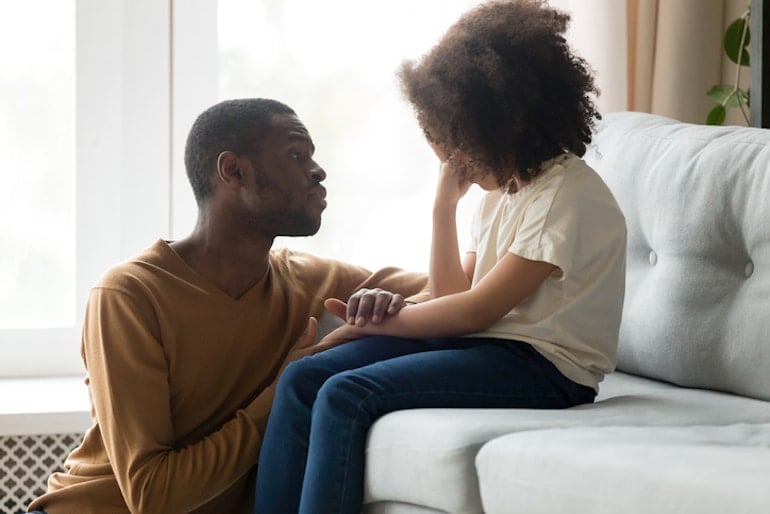Medically Reviewed By
Gaby Vaca-Flores, RDN, CLE
Registered Dietitian Nutritionist
Here’s a closer look at how and why we shed tears. Plus: seven health benefits of crying for your mood and more.
Think back to the last time you cried.
How did you feel afterwards? Better, worse, about the same?
In many cases throughout the literature, crying reduces stress and improves mood. It’s a soothing behavior. This, of course, isn’t a modern revelation.
After all, as the Ancient Roman poet Ovid put it: “It is some relief to weep. Grief is satisfied and carried off by tears.”
In this article, we’ll explore the benefits of crying, mostly as they relate to mood. We’ll ask why, exactly, we might feel better after shedding tears.
But first, let’s explore the basic facts of crying.



What Is Crying?
Crying is defined as the shedding of tears from the lacrimal apparatus—a series of structures and glands surrounding the eye. This tear shedding may be accompanied by changes in facial expression, sounds, and the convulsive inhaling and exhaling known as sobbing. Humans are the only animals that cry. Other animals call out in distress—like when baby birds are separated from their mothers—but we’re the only species that breaks down in tears. Crying is an expression of emotion. It’s a uniquely human response to a wide range of situations and stimuli, from watching a sad film to grieving the loss of a loved one. Charles Darwin, the father of modern biology, didn’t believe that crying had any real purpose for adults. He thought it was merely a relic from childhood, when distressed babies would squeeze out tears through clenched eyelids. Today, however, that view has shifted.
Why Do We Cry?
Crying doesn’t just affect our own mood and stress levels. It also affects the feelings, behaviors, and responses of those around us. In other words, crying likely has two main functions:- Self-soothing
- Social signaling
- get the attention of a caregiver (e.g., baby crying for its mother)
- receive sympathy or empathy from others
- decrease aggression or violence
- bond with others who are upset

Does Crying Make You Feel Better?
It can, but not always. Overall, it depends on the person and the situation. If someone takes ownership of their feelings and embraces crying as an outlet, crying tends to make them feel better. But if a third party is blamed for causing tears, crying tends to make them feel worse. Crying intensity also matters. In one study of 1,004 crying episodes, more intense crying was linked to a better mood, post-cry. Surprisingly, however, the participants reported beneficial effects in only 30 percent of the cries. Another group of researchers studied how crying impacts mood following a sad film. The punchline? Criers felt worse than non-criers. But this doesn’t prove crying makes you feel lousy. Crying might simply be a marker for the folks who felt extra sad. In the good news column, data from over 5,000 men and women across 35 countries suggests that crying can be a cathartic experience. It can release negative emotions and foster positive ones in its wake. What might explain this? Keep reading.7 Crying Benefits For Mood
There are many theories on why crying makes you feel better, and some are more grounded in science than others. Here are the ones worth talking about:1. Crying relaxes you
When you cry, the “rest and restore” parasympathetic nervous system is often activated, and a soothing response kicks in. This relaxation response may be aided by oxytocin, your “cuddle” hormone.2. Crying Eases emotional pain
Some researchers believe that crying causes your body to release opioids, natural painkillers that numb emotional pain.3. Crying Reduces stress hormones
In one study, women who cried more intensely during a movie had greater reductions in cortisol, the stress hormone. Was the cortisol literally oozing out through tears? Monkeys have similar cortisol reductions (sans tears) following distress calls, so one might think not. However, when it comes to other stress hormones, they do appear to release with emotional tears for mood-regulating effects.4. Crying May increase blood flow to the brain
Some scientists theorize that changes in facial muscles during crying (and the fast breathing of sobbing) can stimulate blood flow to the brain and improve mood. However, this theory is far from proven.5. Crying makes us feel more human
Here’s the theory: When we cry, we feel less indifferent, more connected with our emotions, and more vulnerable. In other words, crying makes us feel more human—and therefore, better.
6. Crying as resolution
When do people cry during a sad film? According to a 1979 study, it’s not when the trouble arrives, but when the trouble resolves. Crying may be part of our peace-finding process, helping us resolve obstacles in our life and move forward.7. Crying is rhythmic
Many rhythmic behaviors—conscious breathing, mantra meditation, humming, and even leg swinging—have been shown to promote relaxation. It’s possible that the repetitive, rhythmic nature of sobbing has similar effects.Is Crying Healthy?
Crying is a uniquely human display of emotion. After crying, sometimes we feel better, and sometimes we don’t. It depends on the situation. In general, though, a bit of crying now and then is a perfectly normal (and potentially healthy) behavior. And it might, if we’re lucky, bring us closer to those we love. Note: If you find yourself struggling with frequent bouts of crying, sadness, or other emotional problems, consider seeking help. A qualified mental professional can provide a friendly ear, offer advice, and give you the tools you need to get back on track.More like this









